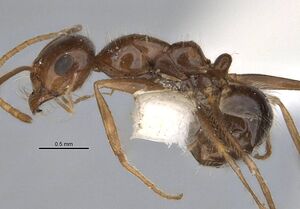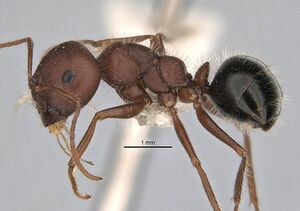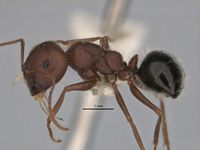Melophorus hirsutipes
| Melophorus hirsutipes | |
|---|---|

| |
| Scientific classification | |
| Kingdom: | Animalia |
| Phylum: | Arthropoda |
| Class: | Insecta |
| Order: | Hymenoptera |
| Family: | Formicidae |
| Subfamily: | Formicinae |
| Tribe: | Melophorini |
| Genus: | Melophorus |
| Species group: | biroi |
| Species complex: | fieldi |
| Species: | M. hirsutipes |
| Binomial name | |
| Melophorus hirsutipes Heterick, Castalanelli & Shattuck, 2017 | |
Melophorus hirsutipes workers form a significant proportion of the catch in many drier areas of Australia. Most material has been taken in pitfall traps. This species and Melophorus lanuginosus seem to be particularly common in heathland, but M. hirsutipes has also been taken in mulga woodland, hummock grassland, and sclerophyll woodland. Red clay soil seems to be a preferred substrate. No data are available on the habits of the species but is probably a generalized scavenger feeding on animal and plant material. (Heterick et al. 2017)
Identification
Heterick et al. (2017) - Melophorus hirsutipes can be placed in the Melophoprus biroi species-group on the basis of characters of the clypeus, propodeum, mandible and palps. The species is also placed in the Melophoprus fieldi species-complex because of the appearance of the anteriorly placed clypeal psammophore, the compact propodeum, the presence of more than one preapical spine on the metatibia, at least in the major worker, the long, even spindly legs and the unmodified mandible in the major worker.
The species is highly variable in appearance: (1) Melophorus hirsutipes (‘‘pillipes’’ - with whorls of fine, erect setae on appendages). This form of the species clusters with several others in the M. fieldi complex which share the following characters: gaster with curved erect setae, semi-erect setae and a few decumbent setae only, genuine appressed setae lacking; the body generally strongly sculptured and hirsute and the antennal scapes and legs with whorls of many fine, straight setae. Melophorus hirsutipes is distinguishable from Melophorus incisus in that the mesonotum and propodeum are not globose and the mesonotum is separated from the mesopleuron and propodeum by a weak groove or indentation. Melophorus hirsutipes can be distinguished from Melophorus ankylochaetes because of the thicker, petiolar node of major and media workers (when viewed in profile), which is more tubercular in appearance and often directed posteriad. The sculpture of the head varies from weakly shining to matt and rugulose. The minor worker has a sloping propodeum with curved, erect setae. (2) The less hirsute form of M. hirsutipes, which lacks erect setae on the tibiae, can be distinguished from similar M. fieldi complex species by the following characters: the mesosoma has long, flexuous, curved erect setae (the pronotal setae and those on anterior mesosoma being curved posteriad, setae on posterior mesonotum being curved anteriad, while those on the propodeum are curved in both directions); rather long appressed setae are present on the mesonotum and gaster but these do not combine to form a silvery pubescence; in profile, the anterior two-thirds of clypeus is often straight or slightly concave, forming an oblique surface, the anteromedial clypeal dimple weak or vestigial and, in profile, the petiolar node in the minor worker is thick, to about 0.7× as wide as high, with its dorsum noticeably directed posteriad in many instances.
Melophorus hirsutipes is one of a cluster of closely related members of the M. fieldi complex that are not only abundant and widely distributed throughout the Australian mainland, but pose at times intractable taxonomic issues. This species, as presently constituted, reveals a bewildering degree of variability in its sculpture and appearance and is by far the most physically variable Melophorus. Specimens at morphological extremes would justifiably be placed in several different taxa were only a few specimens available for analysis. However, in actual fact, many samples of this ant are available. Connecting this bewildering variation are the long, flexuous, mesosomal pilosity, the lack of long, silvery appressed setae that form a thatch and the general appearance of the node. Populations with the ‘pillipes’ condition from the temperate zone are often extremely hairy, smooth and shining with long, tapering metatibiae. The mesosomal dorsum is undulant and most characteristically the clypeus is conspicuously flat, even depressed, with the clypeal psammophore placed high on that sclerite. At the other extreme, workers from the Kimberley region in WA are more compact and may present with a matt, distinctly corrugated appearance to the cuticle (a degree of sculpture that is unusual in Melophorus), a convex, parallel-ridged clypeus and more robust, curved mesosomal setae. Further south, the workers are areolate-rugose. In these latter two cases the petiolar node is broad and explanate (compared with the narrowly ellipsoid, often tilted node in the smoother worker). Workers of other populations still have a matt appearance, but the sculpture is reduced to an even shagreenation, and the shape of the node falls in between these two extremes. Many populations of appearance intermediate between the two extremes exist, but do not necessarily form a morphological cline: workers from the same locality (Merigol Station, QLD) belong to both the smooth, shining morphotype and the areolate-rugose morphotype. Other workers from southern locations do not exhibit the ‘pillipes’ condition and are generally less hirsute. The more markedly sculptured morphs were originally named ‘hispidus’, on the assumption they constituted a good species.
On a five-gene tree, this species is sister to Melophorus inconspicuus and these two taxa in turn are most closely related to Melophorus microtriches.
Distribution
Present in all mainland Australian states.
Distribution based on Regional Taxon Lists
Australasian Region: Australia (type locality).
Distribution based on AntMaps
Distribution based on AntWeb specimens
Check data from AntWeb
Countries Occupied
| Number of countries occupied by this species based on AntWiki Regional Taxon Lists. In general, fewer countries occupied indicates a narrower range, while more countries indicates a more widespread species. |

|
Estimated Abundance
| Relative abundance based on number of AntMaps records per species (this species within the purple bar). Fewer records (to the left) indicates a less abundant/encountered species while more records (to the right) indicates more abundant/encountered species. |

|
Biology
Castes
Worker
   
| |
| Holotype of Melophorus hirsutipes. Worker (minor). . | Owned by Australian National Insect Collection. |
   
| |
| Paratype of Melophorus hirsutipes. Worker (major). . | Owned by Australian National Insect Collection. |
   
| |
| Worker (minor). . | |
   
| |
| Worker (major). . | |
Phylogeny
| Melophorus |
| ||||||||||||||||||||||||||||||||||||
Based on Heterick et al., 2017. Only selected species groups/complexes are included.
Nomenclature
The following information is derived from Barry Bolton's Online Catalogue of the Ants of the World.
- hirsutipes. Melophorus hirsutipes Heterick, Castalanelli & Shattuck, 2017: 253, fig. 58 (w.) AUSTRALIA.
Unless otherwise noted the text for the remainder of this section is reported from the publication that includes the original description.
Description
Worker
(n = 6): CI 106–127; EI 17–32; EL 0.20–0.33; HL 0.72–1.54; HW 0.76–2.06; ML 1.03–2.06; MTL 0.66–1.38; PpH 0.10–0.26; PpL0.40–0.83; SI 67–114; SL 0.87–1.44.
Minor. Head. Head square; posterior margin of head strongly convex or weakly convex; sculpture of frons very variable, from matt, uniformly striate or rugose (northern populations) down a cline to shining with superficial shagreenation or microreticulation only (many southern populations); pilosity of frons a mixture of short, erect and semi-erect setae interspersed with shorter decumbent setae and well-spaced, short, appressed setae. Eye moderate (eye length 0.20–0.49 length of side of head capsule); in full-face view, eyes set above midpoint of head capsule; in profile, eye set anteriad of midline of head capsule; eyes more-or-less circular, elliptical or slightly reniform. In full-face view, frontal carinae straight, divergent posteriad to distinctly concave; frontal lobes straight in front of antennal insertion. Anteromedial clypeal margin broadly and evenly convex with or without anteromedian dimple; clypeal psammophore set at or above midpoint of clypeus; palp formula 6,4. Five mandibular teeth in minor worker; mandibles triangular, weakly incurved; third mandibular tooth distinctly shorter than apical tooth and teeth numbers two and four; masticatory margin of mandibles approximately vertical or weakly oblique. Mesosoma. Integument of pronotum, mesonotum and mesopleuron varying in appearance from matt or weakly shining to strongly shining and mainly smooth (sculpture shagreenate or even striate-rugose on pronotum and dorsum of mesonotum in northern populations and mainly lacking in southern populations with vestigial shagreenation most noticeable on humeri and mesopleuron); anterior mesosoma in profile broadly convex; appearance of erect pronotal setae long (i.e., longest erect setae longer than length of eye) and unmodified; in profile, metanotal groove varying from a vestigial furrow to broadly V or U-shaped; propodeum shining, shagreenate or matt and rugose with multiple hair like striolae; propodeum angulate, propodeal angle blunt; length ratio of propodeal dorsum to its declivity about 4:3, or about 1:1 or smoothly rounded with propodeal dorsum and propodeal declivity confluent (northern populations); erect propodeal setae present and sparse to abundant (greater than 12); appressed propodeal setulae long and separated by at least own length, or sparse or absent, if present then not regularly spaced; propodeal spiracle situated at least twice its width from the declivitous face of propodeum, and shorter (length < 0.50 × height of propodeum), or situated on or beside declivitous face of propodeum, and shorter (length < 0.50 × height of propodeum). Petiole. In profile, petiolar node subcuboidal to rectangular, vertex blunt, directed posteriad; in full-face view, shape of petiolar node uniformly rounded; node weakly to moderately shining (northern) to shining and smooth with vestigial sculpture (southern). Gaster. Gaster shining with superficial microreticulation; pilosity of first gastral tergite consisting of a mixture of curved, erect and semi-erect setae and decumbent and appressed setae that form a variable pubescence, or wholly or mainly of long, curved setae, appressed setae apparently absent. General characters. Colour of foreparts orange-tan or light brown, gaster brown or chocolate.
Major. Head. Head horizontally rectangular, broader than wide; posterior margin of head planar or weakly convex (northern) or weakly concave (southern); cuticle of frons varying along a cline from matt or with a weak sheen, indistinct or coriaceous (northern) to shining with superficial shagreenation or microreticulation only (southern); pilosity of frons a mixture of well-spaced, distinctly longer erect and semi-erect setae interspersed with shorter decumbent or appressed setae. Eye moderate (eye length 0.20–0.49 length of head capsule); in full-face view, eyes set at (northern) or above (southern) midpoint of head capsule; in profile, eye set anteriad of midline of head capsule; eyes elliptical. In full-face view, frontal carinae straight, divergent posteriad, or distinctly concave; frontal lobes straight in front of antennal insertion. Anterior clypeal margin broadly and evenly convex, or broadly convex with anteromedial dimple; clypeal psammophore set at or above midpoint of clypeus; palp formula 6,4. Five mandibular teeth in major worker; mandibles triangular, weakly incurved; third mandibular tooth distinctly shorter than apical tooth and teeth numbers two and four; masticatory margin of mandibles approximately aligned vertically or weakly oblique. Mesosoma. Integument of pronotum, mesonotum and mesopleuron matt or weakly shining and coriaceous (northern) to moderately shining and shagreenate throughout (southern); anterior mesosoma in profile broadly convex; erect pronotal setae long (i.e., longer than length of eye) and unmodified; in profile, metanotal groove shallow (indicated mainly by an angle and the metathoracic spiracles) to broadly V- or U-shaped; propodeum weakly shining with pitted, rugose sculpture dorsally and striate rugosity laterally, or matt or with a weak sheen and indistinctly shagreenate (northern) or propodeum shining and finely striolate and microreticulate (southern); propodeum smoothly rounded or with indistinct angle (northern) or angulate, propodeal angle blunt; length ratio of propodeal dorsum to its declivity between 1:1 and 1:2 (southern); erect propodeal setae present and abundant (at least a dozen); appressed propodeal setae sparse or absent, if present then not regularly spaced (northern) but long, each seta reaching setae behind and in front, but not forming pubescence (southern); propodeal spiracle situated at least twice its width from the declivitous face of propodeum, and shorter (length less than 0.50 × height of propodeum), or situated on or beside declivitous face of propodeum, and shorter (length less than 0.50 × height of propodeum). Petiole. In profile, petiolar node narrowly conical, vertex blunt (northern) to squamiform (southern); in full-face view, shape of petiolar node square with rounded angles, uniformly rounded, or tapered with blunt vertex; node shining and faintly shagreenate-microreticulate. Gaster. Gaster shining, shagreenate (‘LP record’) to shining with superficial microreticulation; pilosity of first gastral tergite consisting of wholly or mainly of long, curved setae, appressed setae apparently absent (mainly northern) or a mixture of curved, erect and semi-erect setae and decumbent setae that form a variable pubescence (mainly southern). General characters. Colour of foreparts orange-tan, gaster brown to chocolate.
Type Material
Holotype minor worker (bottom ant) from Penrose Park, Broken Hill, New South Wales, 10 April 1960, R.H. Mew, dry sclerophyll (typed and hand-written label, respectively) [ANIC32-900147] (Australian National Insect Collection). Paratypes: 2 major workers on same pin and with same details as minor worker (ANIC); 2 major workers and a minor worker from Muloorina HS 29°17'16"S, 137°55'22"E, Lake Eyre South, South Australia, 10 October 2005, S.O. Shattuck #4529, low mound with simple entrance (ANIC ANT VIAL 75-34) [ANIC32-029182] (The Natural History Museum); 2 major workers and a minor worker from Pennrose Park, Broken Hill, New South Wales, 10 April 1960, R.H. Mew, dry sclerophyll [ANIC32-900152] (Museum of Comparative Zoology); minor worker from billabong W Salty Bore, Craven Peak Station 23°01'22"S, 138°13'18"E, Queensland, 11–14 April 2007, C. Lemann, malaise trough, coolabahs and herbs beside billabong [ANIC32-035381] (Queensland Museum); major worker and minor worker from Cambrai, South Australia, 29 February 1972, P.J.M. Greenslade [ANIC32-900155] (South Australian Museum).
Etymology
Latin hirsutus (‘shaggy’) plus pes (‘foot’); adjective in the nominative case.
References
- Heterick, B.E. 2021. A guide to the ants of Western Australia. Part I: Systematics. Records of the Western Australian Museum, Supplement 86, 1-245 (doi:10.18195/issn.0313-122x.86.2021.001-245).
- Heterick, B.E. 2022. A guide to the ants of Western Australia. Part II: Distribution and biology. Records of the Western Australian Museum, supplement 86: 247-510 (doi:10.18195/issn.0313-122x.86.2022.247-510).
- Heterick, B.E., Castalanelli, M., Shattuck, S.O. 2017. Revision of the ant genus Melophorus (Hymenoptera, Formicidae). ZooKeys 700, 1–420 (doi: 10.3897/zookeys.700.11784).
- Majer, J.D., Castalanelli, M.A., Ledger, J.L., Gunawardene, N.R., Heterick, B.E. 2018. Sequencing the ant fauna of a small island: Can metagenomic analysis enable faster identification for routine ant surveys? Sociobiology 65, 422-432 (doi:10.13102/sociobiology.v65i3.2885).
References based on Global Ant Biodiversity Informatics
- Heterick B. E., M. Castalanelli, and S. O. Shattuck. 2017. Revision of the ant genus Melophorus (Hymenoptera, Formicidae). ZooKeys 700: 1-420.

